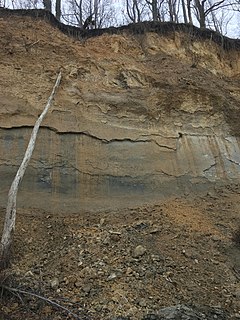This article contains a list of fossil-bearing stratigraphic units in the state of North Carolina, U.S.
The Black Creek Group is a geologic group in North Carolina. It preserves fossils dating back to the Late Cretaceous period.

The Chesapeake Group is a geologic group in Maryland, Virginia, Delaware, and North Carolina. It preserves mainly marine fossils dating back to the Miocene and Pliocene epochs of the Neogene period. This group contains one of the best studied fossil record of Neogene oceans in the world. Professional Paleontologists and amateur fossil hunters alike collect from this group intensely. The Calvert Cliffs stretch the length of Calvert County, Maryland and provide the best continuous stretch of the Calvert, Choptank, and St. Marys Formations. Ward (1985) recommended including the Old Church Formation in this group.
The Cid Formation is a metavolcanic rock and mudstone geologic formation in North Carolina. It consists of a lower unnamed mudstone member with intermittent volcanic flows and the Flat Swamp Member, which is characterized by pyroclastic flows. It preserves fossils dating back to the Ediacaran period.
The Millingport Formation is a geologic formation in North Carolina. It preserves fossils dating back to the Ediacaran period.
The Bear Bluff Formation is a geologic formation in North Carolina. It preserves fossils dating back to the Neogene period.
The Chowan River Formation is a geologic formation in North Carolina. It preserves fossils dating back to the Neogene period.
The Duplin Marl is a geologic formation in North Carolina. It preserves fossils dating back to the Neogene period.
The Pamlico Formation is a geologic formation in North Carolina. It preserves fossils dating back to the Neogene period. The name was suggested by L.W. Stephenson in the North Carolina Geological and Economic Survey journal in 1912
The Pollocksville Formation is a geologic formation in North Carolina. It preserves fossils dating back to the Neogene period.
The Pungo River Formation is a geologic formation in North Carolina. It preserves fossils dating back to the Neogene period.
The Trent Formation is a geologic formation in North Carolina. It preserves fossils dating back to the Neogene period.
The New Bern Formation is a geologic formation in North Carolina. It preserves fossils dating back to the Paleogene period.
The Horry Clay is a geologic formation in North Carolina. It preserves fossils.

The James City Formation is a geologic formation in North Carolina. It preserves fossils.
The Waccamaw Formation is a geologic formation in southeastern North Carolina and eastern South Carolina. It preserves fossils from the early Pleistocene epoch. The Waccamaw Formation contains two informal members: "upper" and "lower". The upper Waccamaw is ~2.1-1.8 million years old. The lower Waccamaw Formation is ~2.4-2.2 million years old.
The Flanner Beach Formation is a geologic formation in North Carolina. It preserves fossils.
The McBean Formation is a geologic formation in South Carolina. It preserves fossils dating back to the Paleogene period.
The Duplin Formation is a geologic formation in North and South Carolina. It preserves fossils dating back to the Neogene period, Pliocene epoch.
The Penholloway Formation is a geologic formation in South Carolina. It preserves fossils.
| Wikisource has original works on the topic: Paleontology in the United States#North Carolina |